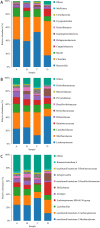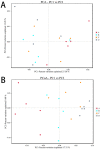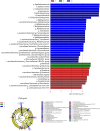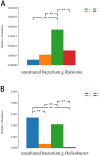Lactobacillus salivarius WZ1 Inhibits the Inflammatory Injury of Mouse Jejunum Caused by Enterotoxigenic Escherichia coli K88 by Regulating the TLR4/NF-κB/MyD88 Inflammatory Pathway and Gut Microbiota
- PMID: 36985229
- PMCID: PMC10055675
- DOI: 10.3390/microorganisms11030657
Lactobacillus salivarius WZ1 Inhibits the Inflammatory Injury of Mouse Jejunum Caused by Enterotoxigenic Escherichia coli K88 by Regulating the TLR4/NF-κB/MyD88 Inflammatory Pathway and Gut Microbiota
Abstract
Replacing antibiotics with probiotics has become an important way to safely and effectively prevent and treat some gastrointestinal diseases. This study was conducted to investigate whether Lactobacillus salivarius WZ1 (L.S) could reduce the inflammatory injury to the mouse jejunum induced by Escherichia coli (ETEC) K88. Forty Kunming mice were randomly divided into four groups with 10 mice in each group. From day 1 to day 14, the control group and the E. coli group were administered with normal saline each day, while the L.S group and the L.S + E. coli group were gavaged with Lactobacillus salivarius WZ1 1 × 108 CFU/mL each day. On the 15th day, the E. coli group and the L.S + E. coli group were intragastrically administered ETEC K88 1 × 109 CFU/mL and sacrificed 24 h later. Our results show that pretreatment with Lactobacillus salivarius WZ1 can dramatically protect the jejunum morphological structure from the changes caused by ETEC K88 and relieve the morphological lesions of the jejunum, inhibiting changes in the mRNA expressions of TNF-α, IL-1β and IL-6 and the protein expressions of TLR4, NF-κB and MyD88 in the intestinal tissue of mice caused by ETEC K88. Moreover, pretreatment with Lactobacillus salivarius WZ1 also increased the relative abundance of beneficial genera such as Lactobacillus and Bifidobacterium and decreased the abundance of harmful genera such as Ralstonia and Helicobacter in the gut. These results demonstrate that Lactobacillus salivarius WZ1 can inhibit the inflammatory damage caused by ETEC K88 in mouse jejunum by regulating the TLR4/NF-κB/MyD88 inflammatory pathway and gut microbiota.
Keywords: ETEC K88; Lactobacillus salivarius; TLR4/NF-κB/MyD88; gut microbiota; inflammatory injury; mice.
Conflict of interest statement
The authors declare no conflict of interest.
Figures













Similar articles
-
Lactobacillus salivarius alleviates inflammation via NF-κB signaling in ETEC K88-induced IPEC-J2 cells.J Anim Sci Biotechnol. 2020 Aug 3;11:76. doi: 10.1186/s40104-020-00488-5. eCollection 2020. J Anim Sci Biotechnol. 2020. PMID: 32774852 Free PMC article.
-
Bacillus coagulans prevents the decline in average daily feed intake in young piglets infected with enterotoxigenic Escherichia coli K88 by reducing intestinal injury and regulating the gut microbiota.Front Cell Infect Microbiol. 2023 Nov 14;13:1284166. doi: 10.3389/fcimb.2023.1284166. eCollection 2023. Front Cell Infect Microbiol. 2023. PMID: 38035331 Free PMC article.
-
Clostridium butyricum Alleviates Enterotoxigenic Escherichia coli K88-Induced Oxidative Damage Through Regulating the p62-Keap1-Nrf2 Signaling Pathway and Remodeling the Cecal Microbial Community.Front Immunol. 2021 Nov 11;12:771826. doi: 10.3389/fimmu.2021.771826. eCollection 2021. Front Immunol. 2021. PMID: 34899723 Free PMC article.
-
Lactobacillus plantarum inhibited the inflammatory response induced by enterotoxigenic Escherichia coli K88 via modulating MAPK and NF-κB signalling in intestinal porcine epithelial cells.J Appl Microbiol. 2021 May;130(5):1684-1694. doi: 10.1111/jam.14835. Epub 2020 Oct 25. J Appl Microbiol. 2021. PMID: 32870564
-
Intestinal receptors for adhesive fimbriae of enterotoxigenic Escherichia coli (ETEC) K88 in swine--a review.Appl Microbiol Biotechnol. 2000 Sep;54(3):311-8. doi: 10.1007/s002530000404. Appl Microbiol Biotechnol. 2000. PMID: 11030565 Review.
Cited by
-
Probiotic characteristics and whole genome sequencing of Pediococcus pentosaceus SNF15 and its protective effect on mice diarrhea induced by Escherichia coli K99.Front Vet Sci. 2025 Mar 13;12:1524658. doi: 10.3389/fvets.2025.1524658. eCollection 2025. Front Vet Sci. 2025. PMID: 40151573 Free PMC article.
-
Bacillus safensis M01 reversed the inflammatory injury of mice jejunum caused by enterotoxigenic Escherichia coli K88.Arch Microbiol. 2025 Mar 14;207(4):87. doi: 10.1007/s00203-025-04287-2. Arch Microbiol. 2025. PMID: 40087175
-
Lactobacillus salivarius and Berberine Alleviated Yak Calves' Diarrhea via Accommodating Oxidation Resistance, Inflammatory Factors, and Intestinal Microbiota.Animals (Basel). 2024 Aug 21;14(16):2419. doi: 10.3390/ani14162419. Animals (Basel). 2024. PMID: 39199953 Free PMC article.
-
Lactiplantibacillus argentoratensis AGMB00912 protects weaning mice from ETEC infection and enhances gut health.Front Microbiol. 2024 Sep 10;15:1440134. doi: 10.3389/fmicb.2024.1440134. eCollection 2024. Front Microbiol. 2024. PMID: 39318427 Free PMC article.
-
Understanding Ligilactobacillus salivarius from Probiotic Properties to Omics Technology: A Review.Foods. 2024 Mar 15;13(6):895. doi: 10.3390/foods13060895. Foods. 2024. PMID: 38540885 Free PMC article. Review.
References
-
- Prieto A., Lopez-Novo C., Diaz P., Diaz-Cao J.M., Lopez-Lorenzo G., Anton C., Remesar S., Garcia-Dios D., Lopez C., Panadero R., et al. Antimicrobial Susceptibility of Enterotoxigenic Escherichia coli from Diarrhoeic Neonatal Calves in Spain. Animals. 2022;12:264. doi: 10.3390/ani12030264. - DOI - PMC - PubMed
Grants and funding
LinkOut - more resources
Full Text Sources

